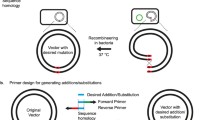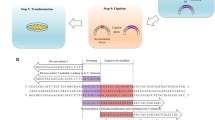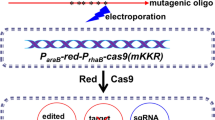Abstract
We describe a method to produce site-directed mutations anywhere within cDNA by assembling mutagenized PCR fragments in proper orientation using lambda integration in an extension of Gateway technology to yield a full-length mutated gene. This process exploits the directionality of lambda insertion sequences ensuring integration and directionality of PCR product into a cloning vector. The process requires only two sequential integration steps to yield a mutagenized expression vector. Mutagenized vasodilator associated phosphoprotein (VASP) was produced by generating two PCR fragments representing the upstream and downstream portions of the gene, substituting alanine or glutamate residues for VASP serine239. The upstream PCR was engineered with attB1 lambda integration sequences at the 5′ region and attB2 at the 3′ region of the downstream fragment to ensure correct orientation. The desired mutation was encoded by the forward primer of fragment 2. The reverse primer of the fragment 1 was phosphorylated for subsequent ligation. Vent polymerase provided sequence accuracy and blunt-ended product. The first integration into a donor vector, catalyzed by BP Clonase II created a linear product circularized by blunt end ligation, yielding hundreds of entry vectors containing the mutagenized VASP. A second integration into destination vector yielded plasmid expressing mutant VASP upon transfection.






Similar content being viewed by others
References
Li, M. Z., & Elledge, S. J. (2005). MAGIC, an in vivo genetic method for the rapid construction of recombinant DNA molecules. Nature Genetics, 37, 311–319. doi:10.1038/ng1505.
Zhang, Y., Buchholz, F., Muyrers, J. P., & Stewart, A. F. (1998). A new logic for DNA engineering using recombination in Escherichia coli. Nature Genetics, 20, 123–128. doi:10.1038/2417.
Khalil, A. M., Julius, J. A., & Bachant, J. (2007). One step construction of PCR mutagenized libraries for genetic analysis by recombination cloning. Nucleic Acids Research, 35, e104. doi:10.1093/nar/gkm583.
Dickinson, R. B., & Purich, D. L. (2002). Clamped-filament elongation model for actin-based motors. Biophysical Journal, 82, 605–617. doi:10.1016/S0006-3495(02)75425-8.
Krause, M., Dent, E. W., Bear, J. E., Loureiro, J. J., & Gertler, F. B. (2003). ENA/VASP PROTEINS: Regulators of the actin cytoskeleton and cell migration. Annual Review of Cell and Developmental Biology, 19, 541–564. doi:10.1146/annurev.cellbio.19.050103.103356.
Lindsay, S. L., Ramsey, S., Aitchison, M., Renne, T., & Evans, T. J. (2007). Modulation of lamellipodial structure and dynamics by NO-dependent phosphorylation of VASP Ser239. Journal of Cell Science, 120, 3011–3021. doi:10.1242/jcs.003061.
Smolenski, A., Bachmann, C., Reinhard, K., Honig-Liedl, P., Jarchau, T., Hoschuetzky, H., et al. (1998). Analysis and regulation of vasodilator-stimulated phosphoprotein serine 239 phosphorylation in vitro and in intact cells using a phosphospecific monoclonal antibody. The Journal of Biological Chemistry, 273, 20029–20035. doi:10.1074/jbc.273.32.20029.
Acknowledgments
This work was supported by the National Institutes of Health grant DK02537, Gatorade Research funds, and JDRF funds to M.S.S., and an NIH T32 Training Grant DK07518 to P.Y.L.
Author information
Authors and Affiliations
Corresponding author
Rights and permissions
About this article
Cite this article
Beem, J.E., Lee, P. & Segal, M.S. Lambda Chops: Creation of Site-Directed Mutants in Insertable Fragments Utilizing Gateway® Technology. Mol Biotechnol 42, 275–281 (2009). https://doi.org/10.1007/s12033-009-9158-8
Received:
Accepted:
Published:
Issue Date:
DOI: https://doi.org/10.1007/s12033-009-9158-8




